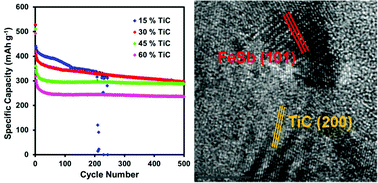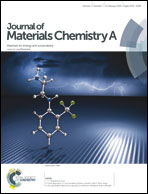High-rate, high-density FeSb–TiC–C nanocomposite anodes for lithium-ion batteries†
Abstract
High-density, high-rate FeSb–TiC–C nanocomposite alloy anodes composed of varying amounts of FeSb, TiC, and conductive carbon black have been synthesized by heating the metallic precursors first followed by high-energy mechanical milling (HEMM) of the product with carbon black. The synthesis method allows for a systematic variation of the TiC and carbon contents within the electrode so that the effects of each component on the electrochemical performance can be understood. The FeSb–TiC–C samples display high tap density (2.9 g cm−3), high reversible specific capacity (450 mA h g−1), superior volumetric capacity (1300 mA h cm−3), and high rate capability (89% retention of the C/5 capacity at 10 C rate). However, realizing a cycle life of >500 cycles requires increased contents of carbon and TiC, which lead to a reduction in reversible capacity and tap density. Incorporation of additives, such as fluoroethylene carbonate (FEC) or vinylene carbonate (VC), into the electrolyte provides moderate improvements in cycle life. The FeSb–TiC–C nanocomposite anodes with a high volumetric capacity at a moderate operating voltage offer an attractive alternative to graphite anodes with safety advantages.


 Please wait while we load your content...
Please wait while we load your content...